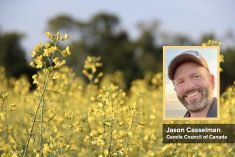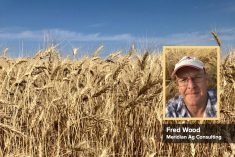In a time of low commodity prices and a growing incentive to maximize profit on every acre, it’s hard enough to accept that some growers are giving up $14 per acre on corn.
It’s unfathomable that they might be losing $84 per acre.
Yet that’s the startling assessment of the impact of delayed herbicide application on the yield of Roundup Ready corn in a study conducted by Dr. Peter Sikkema. Older data on the impact of delayed herbicide application in corn indicated a loss of 0.5 bu./ac./day, but with higher corn yields in the past decade, Sikkema believes the loss is now closer to 1.0 bu./ac./day.
Read Also

Producers aren’t panicking over tariffs and trade threats
The influence of tariff and trade uncertainity on farm business decisions.
In more competitive environments, in fact, the yield loss can run as high as 3.5 bu./ac./day.
In field-scale terms, based on a combination of an average weed pressure, 1,000 acres of corn and a price of $4 per bushel, a one-day delay in herbicide application would result in a yield loss of 0.5 bu./ac./day or $2 per acre for a total $2,000 on those 1,000 acres. A delay of seven days means a $14 per acre loss or $14,000 total loss.
Under “competitive environments” with heavy weed pressure on that same 1,000 acres of corn at the same price, that one-day delay costs $12 per acre or $12,000 per 1,000 acres. In a worst-case scenario where spray application is delayed for seven days, it becomes $84 per acre and $84,000 on 1,000 acres of corn.
Sikkema has long been a proponent of timely herbicide applications, and he believes the positive message actually is getting out and getting acted on. He adds, though, there are a few nuances with the numbers. First, the trials were based on Roundup Ready corn and the use of glyphosate only. Second, there’s been a fairly wide adoption of two-pass weed control in corn lately, and this is reducing the risk.
“Growers appreciate how sensitive corn is to early weed interference,” says Sikkema, a professor of weed science at the University of Guelph’s Ridgetown Campus. “There’s been a shift from total post-emergence programs in corn to two-pass weed control where they’re putting down an effective pre-emergence herbicide followed by a post herbicide to clean up any weed escapes.”
Sikkema stresses that this trend is being driven by profitability, and that growers appreciate how rapidly they’re losing yield during the “critical weed-free period,” which he adds is much shorter than what is cited in some peer-reviewed literature. As a result, growers are adjusting their weed management programs accordingly.
It’s also a departure from using the post-emergence grass products that were part of the 1990s weed control movement. Sikkema recalls the days when growers would wait until weeds emerged, and the recommendation was to spray only the portions of the field that had weeds and use only those herbicides that were required. With that messaging and the introduction of Roundup Ready soybean in 1997 (and corn in 2001), there was a shift away from soil-applied, pre-emergence herbicides to total post programs.
“I think the hidden yield loss — for that matter, the hidden dollar loss — across Ontario was enormous, yet it’s a totally undocumented yield and financial loss,” says Sikkema. “Let’s say there’s a field with 223 bu./ac. corn with a post-only program. If that had been a two-pass program, that same field might have yielded 235. That is undocumented yield and financial loss that has occurred in many fields across the province for years.”

A third proviso worth noting is that past weed management practices can increase a grower’s flexibility when it comes to the herbicide use. There are some farms in southern Ontario, says Sikkema, where families in the past 50 years have had near-perfect weed control of their farms through the use of very effective integrated weed management programs. Those farms today tend to have very low weed pressure, and have a lot of flexibility in terms of when they put on their post-emergence herbicide.
“In contrast to that, we have conducted research on numerous farms in southwestern Ontario during the past 25 years and the yield loss on some of those farms would be tremendous due to early weed pressure,” says Sikkema. He has seen yield loss as early as the one-leaf stage in corn versus some where there’s no yield loss if application is delayed until the eight-leaf stage. “It varies all over the board… it has to be balanced.”
Diversity in the field
In spite of the rise of the four glyphosate-resistant weed species in Ontario — Canada fleabane, giant ragweed, common ragweed and waterhemp — growers do have the tools to manage those weeds in a corn-soybean-wheat rotation.
“It increases the level of management on the part of those farmers who have those resistant biotypes, but with the herbicides that are currently available in Ontario, I think we can manage those weed biotypes,” says Sikkema. “We just have to start talking about diversity and not relying exclusively on herbicides for weed management.”
That diversity comes in all farming practices, including more diverse crop rotations and using as many different herbicide modes of action as possible. It would mean including winter wheat in the rotation where it makes sense and using cover crops after wheat. In soybeans, it might translate to decreasing row widths from 30-inch down to 20- or 15-inch spacings or increasing the seeding rate.
One point of interest regarding the new technologies available to growers such as Roundup Ready Xtend and Enlist is that growers do not force the technologies where they don’t fit. At the same time, it’s important to make full use of them where they do work and work well.
As an example, Roundup Ready Xtend soybeans have an excellent fit for managing glyphosate-resistant Canada fleabane or glyphosate-resistant giant ragweed in Ontario. It’s biologically active on those two weed species. In contrast to that, Sikkema calls it forcing a square peg into a round hole for growers trying to make the Xtend technology work in terms of glyphosate-resistant waterhemp. That has more to do with the biology of the weed and its extended emergence, which begins in May and continues through October. As a result, dicamba in a pre-emerge application of XtendiMax or Engenia might provide 10 to 14 days of residual control of waterhemp before it loses efficacy.
Dicamba is very effective as a post-emergence treatment for the control of glyphosate-resistant waterhemp, but Sikkema cautions that sensitive crops in adjacent fields may have emerged at that time. This puts those at a much greater risk due to off-target movement.
Late-season applications
Another point from Sikkema pertains to late-season herbicide applications, where a grower might apply a pre-emergence herbicide in corn. Though the field has been perfectly clean up to the six-leaf stage (V4), the grower notices some newly emerged weeds. Will those weeds reduce yield? Would it be worth it to apply a post herbicide?
The answers to those questions are “No” and “Probably not.” And Sikkema says this is part of a rather profound shift in the past 10 years.
Sikkema cites a recent paper written by Dr. Jason Norsworthy of the University of Arkansas, who stated that growers need to approach 100 per cent weed control in all fields in all years, and as long as they’re farming, they need to reduce weed seed return to the soil, especially from glyphosate-resistant biotypes.
“The thought is that if there’s no weed seed returned to the soil, we are going to deplete the soil-seed bank, and there are just fewer weeds that are exposed to herbicides,” he says. “As a result, there will be reduced selection intensity for herbicide-resistant weeds in general, and glyphosate-resistant weeds in particular. I’m changing my thought process, and I think we have to look to almost perfect weed control for those weed species that have a greater propensity for selecting or evolving herbicide resistance.”
The primary reason behind this is well known: There have been no new herbicide modes of action for 35 years in field crop production. There might be new modes being developed, but it’s not known whether they will arrive in time to address some of the current weed management challenges. Finally, herbicides should be viewed as an exhaustible resource. Sikkema says more must be done to protect this exhaustible resource so that future farmers will realize the same weed management benefits from these valuable weed management tools.
This article was originally published in the January 2018 issue of the Corn Guide.















